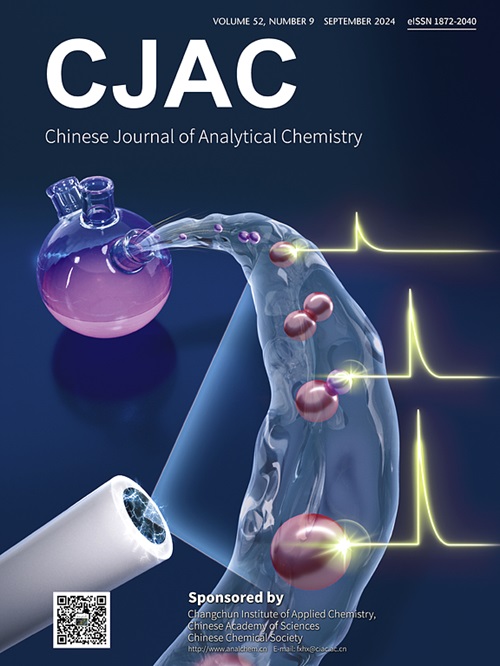Quality assessment and stoichiometric analysis of fresh Citrus reticulata ‘Chachi’ peels based on flavonoids spectrum, bioactivity, and ultra high performance liquid chromatography-fingerprint analysis
IF 1.3
4区 化学
Q4 CHEMISTRY, ANALYTICAL
引用次数: 0
Abstract
The dried and matured pericarp of Citrus reticulata 'Chachi' (CRC), also known as Pericarpium Citri Reticulatae Chachiensis, is a traditional Chinese medicine renowned for its expectorant properties and extensively studied for its efficacy in alleviating cough and asthma symptoms. Ensuring the quality control of fresh CRC is crucial for its efficacy and safety. This study evaluated the quality and efficacy of CRC from the main production areas in Xinhui District. First, multi-wavelength fusion technology was employed to establish ultra high performance liquid chromatography (UHPLC) fingerprint analysis. Second, the in vitro antioxidant activity of fresh CRC peel samples was assessed using DPPH (2,2-diphenyl-1-picrylhydrazyl) and ABTS (2,2′-azinobis (3-ethylbenzothiazoline-6-sulfonic acid)) scavenging assays. Additionally, grey relational analysis (GRA) and partial least squares (PLS) modeling were used to correlate fingerprint patterns with efficacy parameters. Eleven major flavonoid compounds and total flavonoids were quantified across 26 samples. Finally, technique for order preference by similarity to ideal solution (TOPSIS) analysis comprehensively evaluated the overall quality of fresh CRC peels from these production areas. The results demonstrated a high degree of similarity among the 26 samples, ranging from 0.850 to 0.997. Notably, 21 peaks were identified as significant contributors (variable importance in the projection (VIP) > 0.7), including hesperidin, didymin, 3′-demethylnobiletin, and demethylnobiletin. Furthermore, TOPSIS and entropy weight analysis indicated that Gujing, Daze, and Luokeng exhibited superior overall quality. This study provides scientific evidence to support quality control and efficacy evaluation of fresh CRC peels.

基于黄酮类化合物光谱、生物活性和超高效液相色谱-指纹图谱分析的新鲜柑桔果皮质量评价及化学计量学分析
干燥成熟的柑桔果皮(CRC),又称柑桔果皮(Pericarpium Citri Reticulatae Chachiensis),是一种以祛痰特性而闻名的传统中药,其缓解咳嗽和哮喘症状的功效被广泛研究。确保新鲜CRC的质量控制对其有效性和安全性至关重要。本研究对新会区主产区结直肠癌的质量和疗效进行了评价。首先,采用多波长融合技术建立超高效液相色谱(UHPLC)指纹分析方法。其次,采用DPPH(2,2-二苯基-1-picrylhydrazyl)和ABTS (2,2 ' -azinobis(3-乙基苯并噻唑-6-磺酸))清除法评估新鲜CRC果皮样品的体外抗氧化活性。此外,采用灰色关联分析(GRA)和偏最小二乘(PLS)模型将指纹图谱与疗效参数进行关联。测定了26份样品中11种主要类黄酮化合物和总黄酮的含量。最后,采用TOPSIS (order preference technique by similarity to ideal solution)分析方法,对产区新鲜CRC果皮的整体质量进行综合评价。结果表明,26个样本的相似性在0.850 ~ 0.997之间,具有较高的相似性。值得注意的是,21个峰值被确定为显著贡献者(投影中的可变重要性(VIP) >;0.7),包括橙皮苷、二甲苷、3′-去甲基皂素和去甲基皂素。TOPSIS和熵权分析表明,古井、大泽和罗坑的综合质量较优。本研究为鲜食结直肠癌果皮的质量控制和疗效评价提供了科学依据。
本文章由计算机程序翻译,如有差异,请以英文原文为准。
求助全文
约1分钟内获得全文
求助全文
来源期刊
CiteScore
3.60
自引率
25.00%
发文量
17223
审稿时长
35 days
期刊介绍:
Chinese Journal of Analytical Chemistry(CJAC) is an academic journal of analytical chemistry established in 1972 and sponsored by the Chinese Chemical Society and Changchun Institute of Applied Chemistry, Chinese Academy of Sciences. Its objectives are to report the original scientific research achievements and review the recent development of analytical chemistry in all areas. The journal sets up 5 columns including Research Papers, Research Notes, Experimental Technique and Instrument, Review and Progress and Summary Accounts. The journal published monthly in Chinese language. A detailed abstract, keywords and the titles of figures and tables are provided in English, except column of Summary Accounts. Prof. Wang Erkang, an outstanding analytical chemist, academician of Chinese Academy of Sciences & Third World Academy of Sciences, holds the post of the Editor-in-chief.

 求助内容:
求助内容: 应助结果提醒方式:
应助结果提醒方式:


